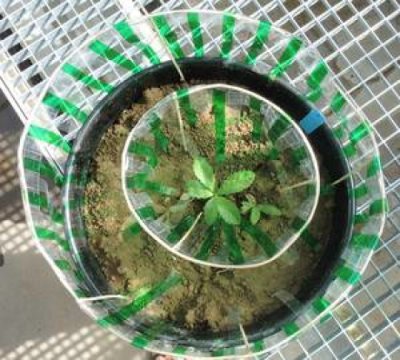
How? Smell: From ScienceDaily:
Plants detect a class of odor molecules known as volatile organic compounds, which are essential for many plant survival strategies, including attracting birds and bees, deterring pests, and reacting to disease in nearby plants. These compounds also give essential oils their distinctive scents.
Touhara’s team exposed tobacco cells and 4-week-old tobacco plants to different volatile organic compounds. They discovered that odor molecules change gene expression by binding to other molecules called transcriptional co-repressors that can turn genes on or off.
In plants, the odor molecules must move into the cell and accumulate before they affect plant behavior. In animals, odor molecules are recognized by receptors on the outside of cells in the nose and immediately trigger a signaling pathway to recognize the odor and change behavior.
“Plants can’t run away, so of course they react to odors more slowly than animals. If plants can prepare for environmental change within the same day, that is probably fast enough for them,” said Touhara.
Speed is unnecessary for plants, but they may be able to recognize a much greater variety of odor molecules.
“Humans have about 400 odor receptors. Elephants have about 2,000, the largest number in animals. But based on how many transcription factor genes are in plants, plants may be able to detect many more odors than animals,” said Touhara. Paper. (open access) – Ayumi Nagashima, Takumi Higaki, Takao Koeduka, Ken Ishigami, Satoko Hosokawa, Hidenori Watanabe, Kenji Matsui, Seiichiro Hasezawa, Kazushige Touhara. Transcriptional regulators involved in responses to volatile organic compounds in plants. Journal of Biological Chemistry, 2018; jbc.RA118.005843 DOI: 10.1074/jbc.RA118.005843 More.
One wonders whether plants could be used to detect CO or other toxic gases and send signals accordingly. But would they be fast enough?
Sound is so elemental to life and survival that it prompted Tel Aviv University researcher Lilach Hadany to ask: What if it wasn’t just animals that could sense sound—what if plants could, too? The first experiments to test this hypothesis, published recently on the pre-print server bioRxiv, suggest that in at least one case, plants can hear, and it confers a real evolutionary advantage.
Note: “ … and it offers a real evolutionary advantage.” What if the writer had just said, “ … and it offers a real advantage.”?What is “evolutionary” doing in that sentence?
Hadany’s team looked at evening primroses (Oenothera drummondii) and found that within minutes of sensing vibrations from pollinators’ wings, the plants temporarily increased the concentration of sugar in their flowers’ nectar. In effect, the flowers themselves served as ears, picking up the specific frequencies of bees’ wings while tuning out irrelevant sounds like wind.Michelle Z. Donahue, “Flowers can hear buzzing bees—and it makes their nectar sweeter” at National Geographic
Hadany describes herself as an “evolutionary theoretician,” which probably explains the verbiage, which just sits there in the sentence even though we have no idea of the details of how the plants came to have the facility for picking up sounds that she describes.
“We were quite surprised when we found out that it actually worked,” Hadany says. “But after repeating it in other situations, in different seasons, and with plants grown both indoors and outdoors, we feel very confident in the result.” Michelle Z. Donahue, “Flowers can hear buzzing bees—and it makes their nectar sweeter” at National Geographic
So picking up the plant hearing easily was a surprise to the team too, despite the evolution theorizing?
The team did a great piece of work on plant hearing. But so much language around “evolution” is just clutter, creating the impression that we know things we really don’t. And sometimes that gets in the way of understanding what we see now in real time.
Apparently, the fact that so many flowers are bowl-shaped helps amplify the sound of insects.
See also: Darwinism impedes understanding of plant communications
Can plants be as smart as animals?
Plants are not people but maybe they hear things (2012)
and
Is salad murder? If we think plants are “equal organisms” with respect to humans, it’s not clear whether salad is or isn’t murder. Or whether murder is even a serious ethical problem.
Follow UD News at Twitter!